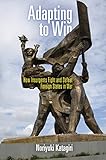Adapting to Win : How Insurgents Fight and Defeat Foreign States in War / Noriyuki Katagiri.
Material type: TextPublisher: Philadelphia : University of Pennsylvania Press, [2014]Copyright date: ©2015Description: 1 online resource (312 p.) : 5 illusContent type:
TextPublisher: Philadelphia : University of Pennsylvania Press, [2014]Copyright date: ©2015Description: 1 online resource (312 p.) : 5 illusContent type: - 9780812246414
- 9780812290134
- 355.02/1801 23
- JC328.5
- online - DeGruyter
- Issued also in print.
| Item type | Current library | Call number | URL | Status | Notes | Barcode | |
|---|---|---|---|---|---|---|---|
 eBook
eBook
|
Biblioteca "Angelicum" Pont. Univ. S.Tommaso d'Aquino Nuvola online | online - DeGruyter (Browse shelf(Opens below)) | Online access | Not for loan (Accesso limitato) | Accesso per gli utenti autorizzati / Access for authorized users | (dgr)9780812290134 |
Frontmatter -- Contents -- 1. How Do Insurgents Fight And Defeat Foreign States In War? -- 2. Origins And Proliferation Of Sequencing -- 3. How Sequencing Th Eory Works -- 4. The Conventional Model: The Dahomean War (1890- 1894) -- 5. The Primitive Model: Malayan Emergency (1948- 1960) -- 6. The Degenerative Model: The Iraq War (2003- 2011) -- 7. The Premature Model: The Anglo- Somali War (1900- 1920) -- 8. The Maoist Model: The Guinean War of Independence (1963- 1974) -- 9. The Progressive Model: The Indochina War (1946- 1954) -- Conclusion -- Appendix A. List of Extrasystemic Wars (1816- 2010) -- Appendix B. Description of 148 Wars and Sequences -- Notes -- Bibliography -- Index -- Acknowledgments
restricted access online access with authorization star
http://purl.org/coar/access_right/c_16ec
When insurgent groups challenge powerful states, defeat is not always inevitable. Increasingly, guerrilla forces have overcome enormous disadvantages and succeeded in extending the period of violent conflict, raising the costs of war, and occasionally winning. Noriyuki Katagiri investigates the circumstances and tactics that allow some insurgencies to succeed in wars against foreign governments while others fail.Adapting to Win examines almost 150 instances of violent insurgencies pitted against state powers, including in-depth case studies of the war in Afghanistan and the 2003 Iraq war. By applying sequencing theory, Katagiri provides insights into guerrilla operations ranging from Somalia to Benin and Indochina, demonstrating how some insurgents learn and change in response to shifting circumstances. Ultimately, his research shows that successful insurgent groups have evolved into mature armed forces, and then demonstrates what evolutionary paths are likely to be successful or unsuccessful for those organizations. Adapting to Win will interest scholars of international relations, security studies, and third world politics and contains implications for government officials, military officers, and strategic thinkers around the globe as they grapple with how to cope with tenacious and violent insurgent organizations.
Issued also in print.
Mode of access: Internet via World Wide Web.
In English.
Description based on online resource; title from PDF title page (publisher's Web site, viewed 30. Aug 2021)


